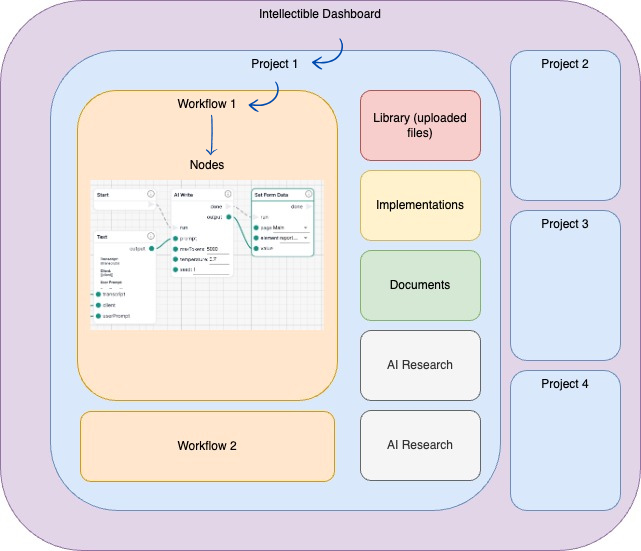Understanding the Structure of Intellectible
Intellectible is structured in a hierarchical manner to efficiently manage projects, workflows, and automation processes. The platform is designed to provide users with a centralized workspace where they can organize workflows, store relevant files, and automate tasks using AI-powered nodes.
The diagram reference (below) visually represents the structure of Intellectible, which can be broken down into the following key components:
- Intellectible Dashboard: The Central Hub
- Projects Dashboard: Organizing Workflows & Resources
- Workflows: The Automation Engine
- Nodes: The Building Blocks of Automation

Intellectible Dashboard: The Central Hub
At the highest level, the Intellectible Dashboard serves as the entry point for all users. It provides an overview of all projects within an organization and allows users to navigate between different projects and resources. The Central Hub
- Displays all active projects.
- Provides access to shared resources like documents, library files, and AI research.
- Allows users to manage team permissions and integrations.
Projects Dashboard: Organizing Workflows and Resources
Each Project represents a workspace dedicated to a specific goal, client, or automation process. Projects contain multiple workflows, a document library, AI research tools, and team permissions settings. A project in Intellectible includes the following sections:
- Workflows – The automation engine of Intellectible, where tasks are executed using a sequence of nodes.
- Library (Uploaded Files) – Stores relevant documents and files used within workflows.
- Documents – Houses reports and structured outputs generated from workflows.
- AI Research – Assists in analyzing and extracting insights from uploaded files.
- Team Permissions – Manages access levels for users within the project.
Workflows: The Automation Engine
A Workflow is a structured sequence of steps that automates data processing, document analysis, and AI-powered tasks. Workflows are made up of nodes, each performing a specific function. Types of Workflows include:
- Data Extraction Workflows – Extract key facts from documents.
- AI Processing Workflows – Use AI models to analyze text and generate structured outputs.
- Integration Workflows – Connect with external systems to automate processes.
Workflow Nodes: The Building Blocks of Automation
Inside a workflow, nodes serve as the core components that execute specific tasks. Each node has a defined purpose, whether it is retrieving data, processing information, or sending outputs.